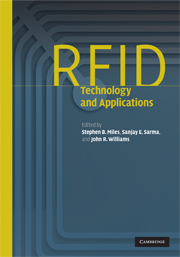Book contents
- Frontmatter
- Contents
- List of contributors
- Preface
- Acknowledgments
- 1 Introduction to RFID history and markets
- 2 RFID technology and its applications
- 3 RFID tag performance optimization: a chip perspective
- 4 Resolution and integration of HF and UHF
- 5 Integrating sensors and actuators into RFID tags
- 6 Performance evaluation of WiFi RFID localization technologies
- 7 Modeling supply chain network traffic
- 8 Deployment considerations for active RFID systems
- 9 RFID in the retail supply chain: issues and opportunities
- 10 Reducing barriers to ID system adoption in the aerospace industry: the aerospace ID technologies program
- 11 The cold chain
- 12 The application of RFID as anti-counterfeiting technique: issues and opportunities
- 13 Closing product information loops with product-embedded information devices: RFID technology and applications, models and metrics
- 14 Moving from RFID to autonomous cooperating logistic processes
- 15 Conclusions
- Appendix – links to RFID technology and applications resources
- Editor biographies
- Index
- References
14 - Moving from RFID to autonomous cooperating logistic processes
Published online by Cambridge University Press: 02 November 2009
- Frontmatter
- Contents
- List of contributors
- Preface
- Acknowledgments
- 1 Introduction to RFID history and markets
- 2 RFID technology and its applications
- 3 RFID tag performance optimization: a chip perspective
- 4 Resolution and integration of HF and UHF
- 5 Integrating sensors and actuators into RFID tags
- 6 Performance evaluation of WiFi RFID localization technologies
- 7 Modeling supply chain network traffic
- 8 Deployment considerations for active RFID systems
- 9 RFID in the retail supply chain: issues and opportunities
- 10 Reducing barriers to ID system adoption in the aerospace industry: the aerospace ID technologies program
- 11 The cold chain
- 12 The application of RFID as anti-counterfeiting technique: issues and opportunities
- 13 Closing product information loops with product-embedded information devices: RFID technology and applications, models and metrics
- 14 Moving from RFID to autonomous cooperating logistic processes
- 15 Conclusions
- Appendix – links to RFID technology and applications resources
- Editor biographies
- Index
- References
Summary
Introduction to autonomous cooperating logistic processes and handling systems
During the last few decades the structural and dynamic complexity in logistics and production has increased steadily [1]. Many causes for higher structural complexity can be found, for instance, in the integration of multiple companies in production and logistic networks. This effect is furthermore amplified by a growing internal and dynamic complexity caused, for example, by an increasing number of product variants. Likewise, dynamic customer behavior intensifies this situation [2]. All these effects combined lead to higher information requirements.
For efficient planning and control a broad and reliable basis of information is needed [3]. However, the underlying algorithms will soon face the end of computation capacity due to the large amount of information that has to be taken into account. It is foreseeable that in the future centralized planning and control methods will not be able to process all the information delivered. A solution to this dilemma is the decentralized storage of necessary information on the logistic object itself as well as the capability of local decision-making. In order to achieve this goal, logistic objects themselves have to become intelligent.
The emergence of these intelligent objects is the foundation for autonomous cooperating logistic processes [4]. The main idea of this concept is to develop decentralized and heterarchical planning and control methods as opposed to existing centralized and hierarchical planning and control approaches. It requires that interacting elements in non-predictable systems possess the ability and the possibility to render decisions independently.
Information
- Type
- Chapter
- Information
- RFID Technology and Applications , pp. 183 - 197Publisher: Cambridge University PressPrint publication year: 2008
References
Accessibility standard: Unknown
Why this information is here
This section outlines the accessibility features of this content - including support for screen readers, full keyboard navigation and high-contrast display options. This may not be relevant for you.Accessibility Information
- 7
- Cited by
